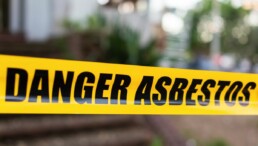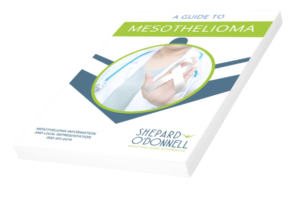Mesothelioma Legal Question: How Long Do I Have to File A Mesothelioma Lawsuit?
As another new year begins and we are all thinking about intentions and resolutions for the coming months, we’d like to add a specific and urgent task to your list: contact a lawyer as soon as possible if you or a loved one has been diagnosed with mesothelioma.
Mesothelioma is an aggressive form of cancer that, once diagnosed, often leaves victims and their families little time to put their affairs in order. Despite the fact that the disease has likely been developing for many years, once you learn that mesothelioma is the cause of the cancer, the clock starts running for you to initiate a potential legal claim.
Nothing can ease the pain of a mesothelioma diagnosis. However, obtaining fair compensation from those responsible for your injuries has the power to ensure your family’s financial security.
The Magic Number: 3 Years (Or More?)
One of Massachusetts’s most frequently asked mesothelioma legal questions is when a lawsuit can be filed. The statute of limitations for personal injury cases in the Commonwealth, including those involving mesothelioma, is three years. This means that you have three years from either 1) the date of your mesothelioma diagnosis, or 2) when you knew or reasonably should have known about the probable link between your diagnosis and prior exposure to asbestos, to file a claim.
It is important that you contact a lawyer as soon as possible after learning you or a loved one has mesothelioma, even if you think you may be outside of the three-year time limit. In certain circumstances, that time frame may have been tolled, or paused, as was the case with the statute of limitations during the COVID-19 pandemic. Your lawyer can tell you if the deadline in your case can be extended past the typical three-year mark. Be sure to contact an attorney intimately familiar with mesothelioma lawsuits in Massachusetts to get the best possible advice for your specific case.
We are happy to provide our honest opinion about whether you have a valid mesothelioma legal claim in Massachusetts, free of charge. Don’t worry if you don’t have your medical records or employment details at hand: we’ll help you obtain whatever documentation we need to build a strong case.
Talk to Your Doctor As Soon As Possible
We recommend talking to your doctor right away if you think you may have been exposed to asbestos at any point during your working years, particularly if you’ve worked in industries such as shipping, plumbing, construction, paper mills and others, or if you are a Veteran. Set up regular monitoring of your lung health, such as annual lung scans or other checks to ensure you spot potential symptoms of mesothelioma as early as possible. We urge you not to ignore the warning signs of mesothelioma which include:
- Shortness of breath
- Difficulty breathing
- Difficulty swallowing
- Chest pains
- Coughing blood
- Loss of appetite
- Sweating (profusely)
- Weight loss
Talk to your doctor right away if you experience any of these symptoms and be sure to let them know about your past asbestos exposure.
Remember: the earlier the diagnosis, the more treatment options may be available to you or your loved one, and the greater the likelihood of recovery.
If you do experience any of these symptoms, or have been recently diagnosed with mesothelioma, we also encourage you to talk to your family about your work history to begin putting the puzzle pieces together about when, where and how you may have been exposed to asbestos. Since the only known cause of this disease is asbestos exposure, it is important to establish and document that history, particularly if you plan to pursue a lawsuit. Let your loved ones know how you may have been exposed to asbestos, what employers you worked for, which job sites you worked at, what equipment you used and who your co-workers were. All of this information will be important to a successful legal claim and the sooner we begin building your case, the greater the likelihood you will be awarded compensation. Read more about what to do if a family member has been diagnosed with mesothelioma.
Think About Possible Secondary Asbestos Exposure
When asbestos dust settles into clothing, furniture, shoes, hair, car upholstery and elsewhere, it can be re-released into the air when disturbed. Because of this, some people have unknowingly exposed loved ones to asbestos at home, even if that loved one has never worked around asbestos themselves. Sadly, a simple welcome-home hug could send fibers into the air to be breathed in by family members.
Unfortunately, this unwitting transfer is the primary method by which many women and children were exposed to asbestos in the early to mid-1900s. We’ve seen first-hand the terrible suffering of one of our clients who developed mesothelioma as a result of doing her husband’s laundry over many years: the asbestos dust embedded in his clothing became dislodged as she handled the items and she then breathed in those toxic fibers. This was a devastating burden to bear for her husband; however, since they were able to put the pieces together of how she developed mesothelioma, they were able to receive substantial compensation for her injuries.
If you or a close family member worked around asbestos during their lifetime and has developed mesothelioma, we encourage you to think about whether you might be able to seek financial compensation for their suffering. Understandably, an overwhelming sense of guilt leads some people into denial, but rest assured, there was no way to know about the dangers of asbestos fibers if the companies didn’t tell you about them.
Companies that knowingly perpetuated the use of this harmful material for decades after it was known to be dangerous should be held accountable. It was their responsibility to warn purchasers and users about the true hazards, and to list the precautions that should be taken to fully protect against exposure to asbestos from their products. They didn’t and allowed hundreds of thousands of people to suffer.
Time Is Of The Essence
Many mesothelioma victims are successfully filing lawsuits in Massachusetts to get the compensation they deserve. However, in order to recover maximum financial awards for your asbestos-related injuries, it is important to file a claim as quickly as possible to ensure that your claim falls within the three-year statute of limitations, and that we have time to gather the evidence we need regarding your work history and potential exposure.
Call us today if you think you might have a mesothelioma legal claim and we will help you navigate the process. At Shepard O’Donnell, we have helped hundreds of individuals and their families get justice for their injuries, regularly obtaining settlements and verdicts in the millions. We are happy to offer you a free case evaluation and will tell you honestly if we think you have a viable claim.
Avoiding Asbestos in Hidden Holiday Hazards
The holidays can be a time of contrasts: chaos and contemplation, stress and relaxation, consumption and giving, excess for some and scarcity for others.
In the spirit of balance, we at Shepard O’Donnell want to wish you the happiest of holidays and also warn you of some of the hidden dangers that can be lurking where you least expect them.
You might not be surprised that we urge caution when taking decorations out of your great-grandmother’s attic: older attics may still contain asbestos insulation and rustling around up there can disturb fibers and dust that you might then bring down into your living space.
But you may be quite surprised to learn that asbestos might be hiding in some of the vintage wine you are saving for a special occasion! While it’s now illegal, asbestos was used in wine filtration systems across the industry up to the 1970s. Experts say that asbestos fibers are less likely to be found in finer, more expensive wines and that it is relatively rare that you still find wine contaminated with asbestos today.
Although many of the following items no longer pose an imminent threat, we wanted to share a few holiday-related products in which you might find lingering asbestos:
Fake Snow
The ideal of a “white Christmas” has been around for decades, popularized by countless movies and songs, and many people wanted to bring that beauty inside. White asbestos, or chrysotile, has a fluffy texture and was once sold as fake snow. People could buy packs of chrysotile, marketed under names like Snow Drift and Pure White, to create festive snowy scenes at home! Unbelievably, the company that made these products advertised them as “safe snow for holiday decorations,” and many people used it to create wintery scenes or flock the Christmas tree.
Sadly, even Hollywood fell for this misguided advice: The classic film, The Wizard of Oz, used 100% asbestos for the snow that rained down on Dorothy and her friends, and others like Holiday Inn and It’s a Wonderful Life also used it for their snow scenes.
Vintage Ornaments
Vintage ornaments and other decorations that have a look of frost or snow were probably also made from asbestos. If you’ve inherited decorations from older relatives or purchased them at an antique store, check closely for that telltale dusting of white.
Model Train Sets
The “snow” was also commonly thrown around toy train sets that circled the Christmas tree or even in the elaborate model railway layouts that may have been set up in your grandfather’s basement. Some modelers also used powdered asbestos, dyed green, as ground cover and it was also often found in plaster.
Old Holiday Lights
Because asbestos was prized for its fire-resistant qualities, old string lights and wires were often insulated with this material. Be very careful when handling these items, especially if you notice any damage.
Artificial Fireplace Ash
Artificial ash made out of asbestos was often used in private homes to create a fake glow in artificial fireplaces before it was banned in 1977. Needless to say, this ash was readily breathed in and posed a real danger to people looking to create a warm ambience during the cold winter months.
Household Fabrics
Again, the fire-resistant properties of asbestos made it “ideal” for fabrics that might potentially catch fire during normal use, such as oven mitts, tablecloths, mats, and even Christmas tree skirts. Many such products manufactured in the early part of the 20th century were made with asbestos.
Children’s Pajamas
In a misguided attempt to keep children safe, clothing manufacturers made kid’s pajamas with flame-retardant materials containing asbestos. These were not banned until the 1970s!
Older Household Appliances
Crock pots, toasters, ovens, irons, coffee pots, bottle warmers, popcorn poppers, hair dryers and more used asbestos as insulating material, either to keep their outsides cool, their contents warm, or to insulate their wires. Today, these products don’t pose too much exposure risk to users unless they have damage.
Curtains
Asbestos curtains first became popular in movie theaters, where the large stage curtain was at risk of catching fire due to the close proximity of hot stage lights. Asbestos curtains were also marketed to homeowners for their fire-resistance and sound insulation benefits and could be found in luxury homes built before 1980.
Books
The binding of some old books, even those bound as late as the mid 1900s, have been found to contain asbestos. Most famously, the first editions of Fahrenheit 451 by Ray Bradbury (a novel in which books were banned and any that were found were burned) were released with fire-proof asbestos binding.
Crayons
As late as 2015, Disney- and Nickelodeon-branded crayons depicting Mickey Mouse, Teenage Mutant Ninja Turtles and Power Rangers, were found to contain traces of asbestos. Manufactured in China, these crayons were ultimately recalled and most were disposed of professionally.
Modeling Clay
A Milton Bradley product called Fibro-Clay was a powdery substance used to make paper mache. This product was found to contain asbestos and wasn’t recalled by the Consumer Product Safety Commission until 1983.
Toy “CSI” Crime Scene Kits
These popular toys, based on the ubiquitous TV shows of the same name and sold at Toys ‘R’ Us and other common retailers, were found to contain asbestos in the fingerprinting powder. When dusting for prints and blowing the dust away, children could inhale enough asbestos to cause cancer later in life, according to an Environmental Working Group report in 2007.
Children’s Makeup
Cosmetics and other personal products made with talc are gaining notoriety because talc is frequently contaminated with asbestos fibers. Especially troubling is that asbestos has been found in children’s makeup, including eye shadows and powders, sold by Claire’s and Justice stores as recently as 2020.
Model Airplane Heat Guns
T/F Monokote heat guns used by model airplane hobbyists contained asbestos in the heat shields, and asbestos fibers were released with each use. This product was recalled by the Consumer Product Safety Commission in 1980.
At Shepard O’Donnell, we wish everyone to enjoy a safe and happy holiday season, free from hazards and harm.
Michael Shepard Quoted in Law360 article on Asbestos Claims
Michael Shepard’s insights were featured in Law 360’s article, “Mass. Lawmakers Weigh Ending Asbestos Claims Time Limit.”
“The Massachusetts Legislature is eyeing a sweeping change to the state’s construction tort statute of repose by eliminating an ironclad six-year limit on certain construction-related asbestos claims, something proponents say would fix a “draconian” interpretation of the law that leaves many families without legal options.”
Michael Shepard Law 360 , “The statute of repose was never designed to insulate companies that knowingly and intentionally used a toxic product … knowing that product won’t cause an injury to people until after the statute of repose has expired,” said Mike Shepard of Shepard O’Donnell, whose firm represented the Oliver estate before the SJC in a suit against General Electric and Metropolitan Life Insurance.
“A company like GE could install asbestos products today and be fully free, because no one will get an injury within the statute of repose time frame. It takes decades for your injury to manifest,” Shepard added. “We don’t see any downside to changing this law.”
Repealing The Massachusetts Statute of Repose
What Is It and Why Does it Matter to Victims of Mesothelioma?
What is a Statute of Repose?
Similar to a statute of limitations, a statute of repose imposes a time limit on when injured parties can file a lawsuit to try to recover compensation after they have been injured. Unlike a typical statute of limitations, however, the statute of repose applies to claims against people or companies involved in the design, planning, construction, or renovation of construction projects.
A statute of repose is intended to protect architects, engineers, and construction contractors from claims that arise due to mistakes or structural failures more than six years after construction work was completed. After six years, it is assumed that these parties no longer have control of the property, have no role in how it is maintained, and are not in a position to observe and fix any defects. The real-world effects of this legislation, however, are much more devastating.
The Fatal Flaw
The Massachusetts statute of repose includes not only a time limit on claims for construction-related issues, but also the manifestation of illnesses caused by the construction activity, including those that were not discovered until many years later. This is the statute’s fatal flaw. The current statute does not account for latent diseases (those with very long incubation periods before symptoms appear) that, by their very nature, won’t be discovered until long after the six-year repose period has expired.
In the case of disease caused by asbestos exposure, the latency period is 20-50 years after exposure occurred! Mesothelioma is a fatal cancer, the only known cause of which is asbestos exposure. This means that a person diagnosed with mesothelioma today has to look back at least 20 years to determine the cause of his or her disease, well past the six-year time limit of the statute of repose.
The Massachusetts statute of repose was enacted in 1968 before the devastating effects of asbestos exposure were understood. Keeping the 1968 legislation in place today fails to consider what we’ve learned in the intervening years. It essentially gives companies blanket immunity for past—and current—misdeeds related to asbestos use and provides no recourse to victims of asbestos exposure.
It’s time that changed.
A Devastating Legacy of Greed and Disease
The health hazards of asbestos have been known by asbestos manufacturers since the 1930s, but were covered up to continue profiting from its sale. It wasn’t until the 1960s that information about the dangers of asbestos began to spread. When OSHA was formed in 1970, the first emergency standard it passed was a ban on the use of asbestos insulation.
But even as the dangers of asbestos were brought to the public’s attention throughout the 1970s and 80s, companies still used asbestos-containing products without warning workers or taking precautions to prevent workers from breathing in the deadly asbestos dust.
The legacy of asbestos use is an ugly story of corporate greed, negligent decision-making, and callous disregard for the health and safety of working men and women and their families. These families all have one thing in common: they were exposed to asbestos decades ago and are just now being diagnosed with disease, including mesothelioma and lung cancer.
They include men and women that worked in the paper mills in Lee, the shipyards in Quincy, Boston, and Charlestown, mills in Lowell and the Blackstone Valley, factories in Fall River, and commercial office towers in downtown Springfield, Worcester, and Boston. Asbestos was also used in powerhouses, factories, shipyards, commercial office buildings, schools, churches, apartment buildings, and homes.
Asbestos-related diseases kill thousands of people every year, including present and former residents of the Commonwealth of Massachusetts. Victims suffering today want justice for their injuries, and so do we.
Victims Can Not Get Justice
For an asbestos personal injury case, the statute of limitations begins when a person is diagnosed with a disease. But, the statute of repose sets a deadline based solely on the passage of time since a construction project was completed, irrespective of whether a person has been diagnosed with a disease or injury by that time.
The statute of repose is inherently unfair to victims of latent diseases caused by exposure to toxic substances during a construction project. By the time these victims develop an injury that gives them a right to pursue a lawsuit for damages, they are already barred from pursuing it in the courts.
Asbestos exposure is like a stick of dynamite with a long fuse. For workers helping to construct a building, the fuse is lit when dust from asbestos products is breathed in during construction. The fuse burns for decades, only to explode into mesothelioma, lung cancer, or asbestosis during their retirement years.
Responsible Parties Can Not Be Held Accountable
Companies that sell or install asbestos in a building are well aware that any harm caused will not become apparent for 20-50 years. Under the current wording of the statute of repose, the contractors and designers of the building cannot be held responsible, even if they knowingly exposed the workers to asbestos.
Today, instead of protecting an architect for a stairway or railing that collapses ten years after a building is turned over to its owner as was initially intended, the statute of repose is being used by large contractors to avoid liability for knowingly injuring workers.
It also means that a school or apartment building being built right now could be using asbestos or other toxic materials, and the contractor would never be held liable for any injuries caused by those toxins.
We Don’t Think That’s Fair
In 2019, Shepard O’Donnell appeared before the Massachusetts Supreme Judicial Court on behalf of mesothelioma victim Wayne Oliver’s widow, June Stearns, in Stearns v. Metropolitan Life Ins. Co. Mr. Oliver worked on the construction site for the Pilgrim Nuclear Power Station in Plymouth, MA, where he was exposed to asbestos-containing products in the 1970s. He was not diagnosed with mesothelioma until 2015.
June Stearns, testified: “Unfortunately, it’s kind of ironic: we would watch the ads on TV (mesothelioma lawsuits) and think how sad that these poor people have this awful disease, not knowing it was laying dormant in Wayne’s body probably right then and had lain there, dormant, for many many years without any kind of symptoms. Then, all of a sudden, he was diagnosed with mesothelioma.”
“He was a healthy man, fit as fiddle, and young and vibrant. We worked together for many years and we were enjoying our life together until that awful disease reared its ugly head,” she went on. “He was in such pain and in a wheelchair and on oxygen – just not living the life he wanted to live, so he finally gave up. It was 16 months after diagnosis, and then he died July 25, 2016.”
The court denied Mr. Oliver’s family compensation citing the statute of repose, which effectively barred him and his family from bringing suit against the parties responsible for his injuries. We don’t think that’s fair.
The Court Agrees
Fortunately, the Supreme Judicial Court of Massachusetts agrees, recognizing the inherent unfairness of the current statute of repose. The court recognized the “regrettable” effects of the current statute of repose, and wrote that the appropriate recourse to change the law is not in the courts, but in the legislature. It further encouraged the legislature to look to the example of other states that have exempted asbestos-related illnesses from their own statutes of repose. Some have done away with the construction statute of repose altogether, while others have carved out exceptions for latent diseases to protect victim’s rights.
House Bill 1746 is currently before the Massachusetts legislature and would change the Massachusetts Statute of Repose, exempting latent diseases such as those caused by exposure to asbestos.
The Way Forward
Shepard O’Donnell is proud to be at the forefront of this push to change the law in Massachusetts. On behalf of the Massachusetts men and women that we represent, who are suffering and dying from asbestos-related diseases, we are actively urging the Legislature to follow the suggestion of the Supreme Judicial Court and support House Bill 1746, to protect the rights of victims of exposure to toxic substances, including asbestos. This Bill would not only protect workers’ rights but also serves as a deterrent to companies that might otherwise use dangerous toxic products in the construction of buildings in the Commonwealth.
If you or someone you know has been exposed to asbestos or has been diagnosed with mesothelioma, lung cancer, or asbestosis, we want to help. Contact us here or call us anytime at 617-451-9191.
Watch a segment of Attorney Michael Shepard testifying in front of the Massachusetts State Legislature about the Statute of Repose.
Erika O'Donnell Featured in Super Lawyers Article
Erika O’Donnell was recently quoted in Super Lawyers’ article discussing the actions you must take, and when, if you or a loved one fall ill from asbestos.
By Super Lawyers staff on January 25, 2021
YOU HAVE 3 YEARS TO FILE A MESOTHELIOMA LAWSUIT IN MASSACHUSETTS
The actions you must take, and when, if you or a loved one fall ill from asbestos
COVID-19 Countermeasures: Liability Immunity Under The PREP Act
Written by: Giuliana D’Esopo
On March 17, 2020, the U.S. Department of Health and Human Services (“HHS”) published an administrative Declaration providing broad legal immunity for manufacturers, suppliers, and administrators of certain countermeasures used against COVID-191. Negligence cases regarding covered countermeasures will be barred, limiting an injured party’s possible redress to the Countermeasures Injury Compensation Program (“CICP”).
The authority to issue such declaration arises out of the Public Readiness and Emergency Preparedness Act (the “PREP Act”).2 Congress enacted the PREP Act in 2005 as a response to fears about an avian influenza (H5N1) pandemic.3 Through the issuance of such PREP Act declaration, the Secretary makes a determination that a disease, condition, or other threat to health constitutes a public health emergency and specifies, among others, the category of diseases, health conditions, or threats to health for which the Secretary recommends the administration or use of the covered countermeasure, and the period during which the liability protections are in effect.4
The PREP Act defines “covered countermeasure” by outlining three categories.5 The first consists of “qualified pandemic or epidemic products” and includes products (drugs, biological products, and devices) manufactured, used, designed, developed, modified, licensed, or procured to diagnose, mitigate, prevent, treat, or cure a pandemic or epidemic or to limit the harm such pandemic or epidemic might otherwise cause.6 The second category describes “security countermeasures,” and the final category consists of products subject to emergency use authorizations.7 The PREP Act’s liability protections are extremely broad, essentially covering most manufacture, testing, development, distribution, dispensing, administration, or use of designated covered countermeasures absent willful misconduct.
The PREP Act authorizes the Secretary to establish a program to provide compensation to individuals who have suffered serious physical injuries or death as the direct result of the administration or use of a covered countermeasure, called the Countermeasures Injury Compensation Program (“CICP”).8 Eligible requesters include injured countermeasure recipients, survivors of deceased injured countermeasure recipients who died as a direct result of the administration or use of a covered countermeasure, and executors or administrators on behalf of the estates of deceased injured countermeasure recipients (regardless of their cause of death).9 Requesters will need to prove causation pursuant to CICP’s standard: proof that is based on “compelling, reliable, valid, medical, and scientific evidence.”10 A temporal association between receipt of the countermeasure and onset of the injury is insufficient.
Requesters who successfully demonstrate causation can recover reimbursement for reasonable and necessary medical services and items to diagnose or treat a covered injury or its health complications; lost wages; and death benefit for certain survivors.11 Benefits under CICP will only be paid after the requester has in good faith attempted to obtain available coverage from all third-party payers with an obligation to pay for or provide such benefits, and the requester must provide the information of such payers.12 If a request is denied, the requester can motion the Secretary of HHS to review the determination, but there is a broad statutory prohibition against any further review.13
It is too early to predict the effectiveness of CICP as a route toward remedy for parties injured by covered countermeasures of COVID-19, but compared to traditional tort procedure, it is seemingly unfriendly to requesters. The lack of judicial oversight is cause for concern, with no further appeals available beyond internal review. While traditional tort procedure allows an injured party his day in court, decisions under the CICP are made on an administrative basis. The process for attorneys evaluating a potential case will be to determine the presence of a covered countermeasure and whether the individual or entity that administered it is shielded from tort liability under the Declaration, and to meet the Declaration’s standard for showing causation.
There is a clear need for the development and distribution of life-saving measures to combat the COVID-19 pandemic, and the Declaration helps encourage such innovation. In the pursuit of this goal, is important to consider potential risks and employ reasonable care in the production of such countermeasures.
- Declaration Under the Public Readiness and Emergency Preparedness Act for Medical Countermeasures Against COVID-19, 85 Fed. Reg. 15198 (Mar. 17, 2020).
- 42 U.S.C. § 247d-6d.
- See Pandemic Planning Update II, Department of Health and Human Services (Nov. 13 2006), available at cdc.gov/flu/pandemic-resources/pdf/panflureport3.pdf.
- See 42 U.S.C. § 247d-6d.
- See 42 U.S.C. § 247d-6d(i)(1).
- Id.
- Id.
- 42 C.F.R. § 110 (Countermeasures Injury Compensation Program).
- Id.
- See 42 C.F.R. § 110.20(c) (outlining CICP’s causation requirement).
- See 42 C.F.R. § 110.2 (summarizing available benefits).
- See id.
- See 42 C.F.R. § 110.91 (2018).
Raw Asbestos Imports Quadrupled from January–April 2018 Compared to 2017
Written by: Shepard Law Firm Staff
Washington, DC—The Asbestos Disease Awareness Organization (ADAO), an independent nonprofit dedicated to preventing asbestos exposure, released new research confirming the increase in raw asbestos imports.
The report detailed that according to the U.S. International Trade Commission, from January to April 2018, the chemical industry brought in nearly 260 tons of asbestos from Russia and Brazil. This represents an increase of nearly 400% of the January–April 2017 imports of 67 tons. The president’s administration and the Environmental Protection Agency, who have close ties to the chemical industry, have defended the ongoing imports and use of this deadly substance.
Asbestos is a known carcinogen and there is no safe or controlled use of asbestos. According to the new “Global Asbestos Disaster” paper, asbestos-related diseases account for nearly 40,000 American deaths each year. This year alone, asbestos has been found in children’s makeup, in schools in Pennsylvania, and in a prison hospital in Georgia.
We believe that asbestos use should be eliminated to protect the public and this trend of increasing the importation of asbestos may possibly expose more individuals to health risks. If you or a close family member have developed mesothelioma or other asbestos-related illnesses, please do not hesitate to contact us for a free consultation.
Celebrating National Men’s Health Week
Written by: Erika O’Donnell
This week (June 13 – June 19) was National Men’s Health Week. While mesothelioma affects both women and men, it is a topic that should certainly be a part of any discussion regarding men’s health. Men who have served onboard Naval ships or who have worked in industries that utilized raw asbestos and/or asbestos-containing products such as insulation, gaskets, packing and board, are at risk for contracting an asbestos-related disease.
Diseases Caused by Asbestos Exposure:
Mesothelioma:
- Mesothelioma is a rare form of cancer, typically caused by asbestos exposure. The most common type of mesothelioma is pleural mesothelioma. The pleura is a thin membrane that surrounds the lungs and acts as a lubricant between the lungs and the chest cavity. Pleural mesothelioma is just that—a mesothelial tumor that occurs on and about the pleura. Since this is the most common form of mesothelioma, it is often referred to as a lung cancer. However, other forms of mesothelioma occur in the peritoneum (the membrane that surrounds the organs of the abdomen), stomach, and other organs of the abdomen. Mesotheliomas can be benign, but are most often malignant.
- There is a long latency period between the time that a person is exposed to asbestos and the time that mesothelioma appears—from 20 to over 50 years.
Symptoms include fatigue, cough, muscle weakness, shortness of breath, chest pain, weight loss, fever and night sweats.
Lung Cancer:
- Exposure to asbestos can also cause other forms of lung cancer. In order to determine whether a lung cancer was caused, at least in part, by exposure to asbestos, physicians typically look to see if there are any pleural markings called “plaques” on the lungs. These plural plaques are typically caused by asbestos fibers infiltrating the pleura.
- Symptoms may include cough, shortness of breath, chest pain, hoarseness, weight loss or loss of appetite.
Asbestosis or Asbestos Lung Disease:
- Asbestosis and Asbestos Lung Disease are non-malignant asbestos-related diseases. A series of medical tests that include a Chest CT Scan and a Pulmonary Function Test are used to diagnosis Asbestosis. Both Asbestosis and Asbestos Lung Disease vary in severity. A mild case of asbestosis may have little to no impact on your life at all while a more advanced case of asbestosis may require a person to use oxygen.

What You Should Be Doing If You Have Been Exposed to Asbestos in the Past:
Talk to Your Doctor:
- Tell your doctor that you may have been exposed to asbestos and approximately when the exposure occurred so that your doctor may make an informed decision on whether you should be monitored for potential asbestos-related diseases.
Yearly Physicals:
- It is important for a person who had past asbestos exposure to report any and all symptoms such as chest pain and shortness of breath to their medical care professional. You should also attend your yearly physicals and get yearly chest scans if so prescribed by your doctor.
Quit Smoking:
- While mesothelioma is not caused by smoking cigarettes, it has been shown that people who have had asbestos exposures and smoke are at a greater risk to contract the disease.
During Men’s Health Week and every other week, we at Shepard Law are committed to educating our clients, neighbors, friends, and the general public about the hazards associated with asbestos and with health topics in general. Please check out some of our previous blog articles that may be helpful to you, your brothers, fathers and sons:
http://www.shepardlawblog.com/2016/04/national-healthy-school-day-are-our-school-buildings-healthy/
http://www.shepardlawblog.com/category/lung-cancer-risks/
http://www.shepardlawblog.com/2015/11/5-nutritional-tips-to-help-chemotherapy-patients-stay-on-track/
http://www.shepardlawblog.com/2016/04/how-workers-brought-the-dangers-of-asbestos-home-to-their-families/
And to all the dads out there, have a Happy Father’s Day.
Truth vs. Hope: What to Tell Asbestos Victims
Written by: Michael Shepard
As someone who has represented victims of mesothelioma, lung cancer, and asbestosis over the past two decades, I have witnessed hundreds of clients succumb to terrible diseases. Often times, when meeting a new client, usually in their home, I am asked questions about the disease they have been diagnosed with. Most people pay no attention to the word mesothelioma, but when a doctor tells you that you have it, you want to learn everything you can about it. Given my experience with mesothelioma victims, my clients naturally want to know how their situation compares to others with that disease. The answer is not an easy one.
When someone is diagnosed with mesothelioma, one of their first questions inevitably involves whether they can be cured. The next question is usually how long they have to live. Mesothelioma is a terminal disease, meaning that there is no known cure and the cancer will likely progress to the point where it eventually takes your life. Between those dates is a span of time that every patient wants to know, but no one can accurately predict. While the average survival of someone diagnosed with mesothelioma is six to eighteen months, it can vary greatly depending on multiple factors. Despite looking for a pattern over the years, I still have no idea how long a mesothelioma victim might survive. I have seen clients who have died within three weeks, and clients who have lived more than five years. Age doesn’t seem to be a determining factor, although younger, otherwise healthy mesothelioma clients have as good a chance as anyone. Even so, I have seen victims as young as twenty-one years old succumb to this terrible cancer within a year from diagnosis. I have also seen victims ninety years and older live for three years.
Despite all the advances in medicine and chemotherapy in the past twenty years, science doesn’t seem to be any closer to determining why certain people get mesothelioma and others don’t, much less finding a cure for this disease. It is well established, and beyond debate by anyone other than a lawyer or expert representing asbestos defendants or interests, that mesothelioma is caused by exposure to all forms of asbestos, including chrysotile asbestos. What we don’t know is why two people, working side-by-side around asbestos for twenty years or more, can have such different reactions to asbestos exposure, where one develops mesothelioma while the other does not. When it comes to mesothelioma, there are more questions than there are answers.

This uncertainty is why it is so difficult to talk to new clients about their future. The client is desperate for information, for optimism, for hope. Depending on the bedside manner of the doctors involved, the client may not have been given any answers to those questions. Early in my career, I was frustrated that my clients were not given information about their survival prospects. I went so far as to seek out the advice of cancer doctors, including one who was also an ordained minister. What I came to learn is that doctors have to tread the same delicate path that I had been navigating. On the one hand, doctors feel they owe the patient the courtesy of explaining the disease and its prognosis in plain, frank terms so the patient and his family aren’t misled into thinking that things were going to work out fine in the end. On the other hand, the mind has tremendous control over the body’s ability to fight off disease. If you take away a person’s hope, their will to fight, you all but guarantee that they will not survive long. So how then, do you handle those questions?
I have chosen a middle ground. I ask my clients what their doctors have told them. I ask a lot of questions about their doctor’s visits, their discussions with the doctors, their discussions with their spouse and family members. Based on the answers I hear, I am usually able to determine how much information has been given to them. If they are well informed, and seem to be able to discuss their prognosis candidly, I am more open in the information I provide. If, however, it seems that they either haven’t been given very clear information, or that they aren’t accepting of the information they have been given, I am much more guarded with my comments. I don’t want to take away whatever optimism or hope is helping my client handle the awful struggle with cancer. Regardless of how much information I share, I always offer an empathetic ear and a solemn promise to do what I can to help. Most often, I find that my clients are happy to know that someone is looking out for their needs, and for the financial needs of their spouse moving forward. Ultimately, it is all I can do for them, and I take that responsibility very seriously.
I don’t know if my approach is right or wrong, but I suspect that it depends on the situation and it depends on the person. When faced with the sudden and unexpected diagnosis of mesothelioma, would you want the truth, or would you prefer hope?
Case Spotlight: The Auto Mechanic’s Wife
Written by: Shepard Law Firm Staff
When someone is diagnosed with an asbestos-related disease such as mesothelioma or lung cancer, they are often asked where and how they were exposed to asbestos. For people who did not work in asbestos-related industries or trades, it can be difficult to determine how they were exposed. This is often the case with women who have been diagnosed with an asbestos-related disease and were either housewives or worked in fields that did not have obvious exposures to asbestos-containing products.
When determining where a person (who had little or no direct exposure to asbestos) may have encountered asbestos fibers, attorneys often look to family members who lived with the individual for significant periods of time. Husbands and fathers of the sick individual often worked in trades that involved frequent contact with asbestos-containing products. Asbestos fibers from these products were then brought home on clothing and into the family home and car. Anyone washing the work clothing of individuals who frequently worked with asbestos-containing products was at an increased risk of developing an asbestos-related disease.
Our firm recently represented the family of a woman who never worked directly with any asbestos-containing products, and did not work in any commercial or industrial locations where asbestos products were present. In trying to determine how she may have been exposed, the occupations of her family members were explored. Her husband had worked for a number of years as a truck driver and mechanic and was responsible for performing brake and clutch jobs on the trucks he drove. She was responsible for washing the clothes he wore to work every day, clothes that transported asbestos fibers home and into her lungs.
Brake linings, clutch facings, and a variety of gaskets on automobiles contained asbestos until very recently. Brake linings were one of the last products to have asbestos removed from them, and asbestos-containing brake linings were sold as recently as 2001. When old brake linings and clutch facings were removed and replaced, the brake or clutch was often cleaned out with an air hose or cloth rag. The cleaning created a significant amount of dust, which the worker would breathe in and collect in his hair and on his clothing.

Many people want to ask the obvious question: how is it that the wife or other family member of the worker became sick and not the worker himself? The answer is that not everyone who is exposed to asbestos will develop an asbestos-related disease. Some people work directly with asbestos products every day for years and never get sick, while others develop mesothelioma with only limited exposure to asbestos. Additionally, the latency period for developing asbestos-related disease ranges from approximately 20 to 50 years. This means that most people who develop asbestos-related diseases don’t show any symptoms until decades after they were exposed.
If you or someone you know has an asbestos-related disease and did not work in industries that used asbestos containing products, it’s important to find a firm with extensive experience in investigating such scenarios. Shepard Law has extensive experience reviewing and gathering evidence to help determine the source of asbestos exposure for victims such as these. This experience is crucial because proper documentation and investigation strengthens a client’s case in the legal system. As always, if you suffer from an asbestos-related disease and believe that you have a case, contact us for a confidential consultation.


















